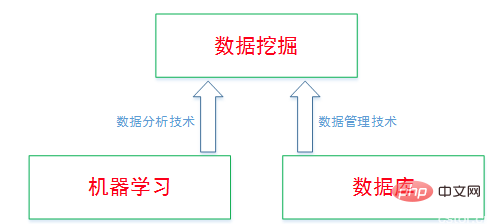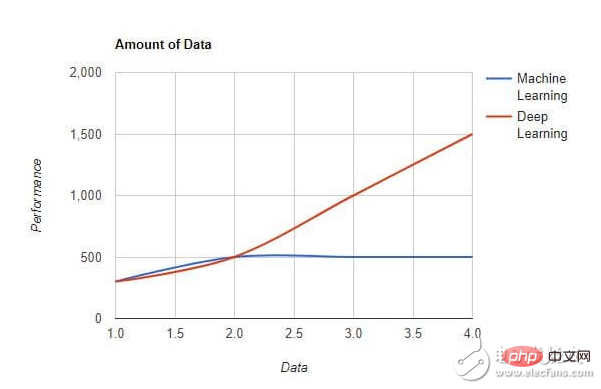 Common Problem
Common Problem
 What is the relationship between artificial intelligence, machine learning, and deep learning?
What is the relationship between artificial intelligence, machine learning, and deep learning?
What is the relationship between artificial intelligence, machine learning, and deep learning?
Machine learning is a subset of artificial intelligence that includes techniques that enable computers to find problems in data and deliver artificial intelligence applications. Deep learning is a subset of machine learning that enables computers to solve more complex problems.

The operating environment of this tutorial: Windows 7 system, Dell G3 computer.
1. Artificial Intelligence
Artificial Intelligence (Artificial Intelligence), the English abbreviation is AI. It is a new technical science that studies and develops theories, methods, technologies and application systems for simulating, extending and expanding human intelligence.
Artificial intelligence is a branch of computer science that attempts to understand the nature of intelligence and produce a new intelligent machine that can respond in a manner similar to human intelligence. Research in this field includes speech recognition , image recognition, robots, natural language processing, intelligent search and expert systems, etc.
Artificial intelligence can simulate the information process of human consciousness and thinking. Artificial intelligence is not human intelligence, but it can think like humans and may even exceed human intelligence.
2. Data Mining
Data Mining, as the name suggests, is to “mining” hidden information from massive amounts of data. According to the textbook, the data here is “large and incomplete.” ", noisy, fuzzy, random practical application data", information refers to "information and knowledge that is implicit, regular, unknown to people in advance, but potentially useful and ultimately understandable". In a business environment, companies hope that the data stored in the database can "speak" and support decision-making. Therefore, data mining is more application-oriented.
Data mining is usually related to computer science and achieves the above goals through many methods such as statistics, online analytical processing, intelligence retrieval, machine learning, expert systems (relying on past rules of thumb) and pattern recognition.
3. Machine Learning
Machine Learning refers to using certain algorithms to guide computers to use known data to derive appropriate models, and to use this model to provide insights into new situations. The process of judgment.
The idea of machine learning is not complicated. It is just a simulation of the learning process in human life. In this entire process, the most critical thing is data.
Any related research on learning algorithms trained through data belongs to machine learning, including many technologies that have been developed for many years, such as linear regression, K-means, prototype-based objective function aggregation class method), Decision Trees (Decision Trees, a graphical method using probability analysis), Random Forest (Random Forest, a graphical method using probability analysis), PCA (Principal Component Analysis, principal component analysis), SVM (Support Vector Machine, support vector machine) and ANN (Artificial Neural Networks, artificial neural network).
4. Deep Learning
The concept of deep learning (Deep Learning) originates from the research of artificial neural networks. A multi-layer perceptron with multiple hidden layers is a deep learning structure. Deep learning discovers distributed feature representations of data by combining low-level features to form more abstract high-level representation attribute categories or features.
Deep learning is a new field in machine learning research. Its motivation is to build and simulate the neural network of the human brain for analysis and learning. It imitates the mechanism of the human brain to interpret data, such as images, sounds and text. .
5. The relationship between artificial intelligence, machine learning, and deep learning
Strictly speaking, artificial intelligence and machine learning are not directly related, but currently machine learning methods are widely used Just solve the problem of artificial intelligence. At present, machine learning is an implementation method of artificial intelligence, and it is also the most important implementation method.
Early machine learning actually belonged to statistics, not computer science; and the classic artificial intelligence before the 1990s had nothing to do with machine learning. So today's AI and ML have a lot of overlap, but there is no strict affiliation.
But if we only look at the computer department, ML belongs to AI. AI has become a very broad subject today.
Deep learning is a popular direction in machine learning. It is itself a derivative of the neural network algorithm and has achieved very good results in the classification and recognition of rich media such as images and speech.
So, if artificial intelligence and machine learning are regarded as two disciplines, the relationship between the three is as shown in the figure below:

If deep learning is regarded as As a sub-discipline of artificial intelligence, the relationship between the three is shown in the following figure:


Machine learning is an important method of data mining, but machine learning is another discipline and is not subordinate to data mining. The two complement each other.
Supplement:
Source: http://m.elecfans.com/article/691751.html
The machine learning process uses the following steps Definition:
1. Identify relevant data sets and prepare them for analysis.
2. Select the type of algorithm to use.
3. Build an analytical model based on the algorithm used.
4. Carry out model training based on the test data set, and modify the model as needed.
5. Run the model to generate test scores.
The difference between machine learning and deep learning
1. Data volume:
Machine Learning can adapt to various data volumes, especially scenarios with small data volumes. On the other hand, if the amount of data increases rapidly, the effect of deep learning will be more prominent. The figure below shows the performance levels of machine learning and deep learning under different amounts of data.

2. Hardware dependency:
Contrary to traditional machine learning algorithms, deep learning algorithms are highly dependent on high-end equipment. Deep learning algorithms need to perform a large number of matrix multiplication operations and therefore require sufficient hardware resources to support them.
3. Feature Engineering:
Feature engineering is the process of putting domain-specific knowledge into specified features, aiming to reduce the level of data complexity and generate data that can be used for learning algorithms mode.
Example: The traditional machine learning model focuses on finding pixels and other attributes needed in feature engineering. Deep learning algorithms focus on other high-level features of the data, thus reducing the actual workload of the feature extractor for each new problem.
4. Problem-solving approach
Traditional machine learning algorithms follow standard procedures to solve problems. It breaks the problem into parts, solves them separately, and then combines the results to get the desired answer. Deep learning solves problems in a centralized manner without splitting the problem.
5. Execution time
Execution time refers to the amount of time required to train the algorithm. Deep learning takes a lot of time to train because it contains more parameters, so the time investment in training is also more significant. Relatively speaking, the execution time of machine learning algorithms is relatively short.
6. Interpretability
Interpretability is one of the main differences between machine learning and deep learning algorithms - deep learning algorithms are often not interpretable . Because of this, the industry will always think twice before using deep learning.
Practical applications of machine learning and deep learning:
- Realize attendance punching through fingerprints, face recognition or license plate scanning Computer vision technology for license plate numbers.
- Information retrieval functions in search engines, such as text search and image search.
- Automated email marketing with specific target identification.
- Cancer oncology medical diagnosis or other chronic disease abnormal state identification.
- Natural language processing applications such as photo tagging. Facebook provides such features to enhance user experience.
- Online advertising.
Future development trends:
- As the industry increasingly uses data science and machine learning technologies, The most important thing for organizations is to introduce machine learning solutions into their existing business processes.
- The importance of deep learning is gradually surpassing machine learning. Facts have proven that deep learning is currently one of the most advanced and most effective technical solutions.
- Machine learning and deep learning will prove their tremendous power in the research and academic fields.
If you want to read more related articles, please visit PHP Chinese website! !
The above is the detailed content of What is the relationship between artificial intelligence, machine learning, and deep learning?. For more information, please follow other related articles on the PHP Chinese website!

Hot AI Tools

Undresser.AI Undress
AI-powered app for creating realistic nude photos

AI Clothes Remover
Online AI tool for removing clothes from photos.

Undress AI Tool
Undress images for free

Clothoff.io
AI clothes remover

Video Face Swap
Swap faces in any video effortlessly with our completely free AI face swap tool!

Hot Article

Hot Tools

Notepad++7.3.1
Easy-to-use and free code editor

SublimeText3 Chinese version
Chinese version, very easy to use

Zend Studio 13.0.1
Powerful PHP integrated development environment

Dreamweaver CS6
Visual web development tools

SublimeText3 Mac version
God-level code editing software (SublimeText3)

Hot Topics
 Bytedance Cutting launches SVIP super membership: 499 yuan for continuous annual subscription, providing a variety of AI functions
Jun 28, 2024 am 03:51 AM
Bytedance Cutting launches SVIP super membership: 499 yuan for continuous annual subscription, providing a variety of AI functions
Jun 28, 2024 am 03:51 AM
This site reported on June 27 that Jianying is a video editing software developed by FaceMeng Technology, a subsidiary of ByteDance. It relies on the Douyin platform and basically produces short video content for users of the platform. It is compatible with iOS, Android, and Windows. , MacOS and other operating systems. Jianying officially announced the upgrade of its membership system and launched a new SVIP, which includes a variety of AI black technologies, such as intelligent translation, intelligent highlighting, intelligent packaging, digital human synthesis, etc. In terms of price, the monthly fee for clipping SVIP is 79 yuan, the annual fee is 599 yuan (note on this site: equivalent to 49.9 yuan per month), the continuous monthly subscription is 59 yuan per month, and the continuous annual subscription is 499 yuan per year (equivalent to 41.6 yuan per month) . In addition, the cut official also stated that in order to improve the user experience, those who have subscribed to the original VIP
 Context-augmented AI coding assistant using Rag and Sem-Rag
Jun 10, 2024 am 11:08 AM
Context-augmented AI coding assistant using Rag and Sem-Rag
Jun 10, 2024 am 11:08 AM
Improve developer productivity, efficiency, and accuracy by incorporating retrieval-enhanced generation and semantic memory into AI coding assistants. Translated from EnhancingAICodingAssistantswithContextUsingRAGandSEM-RAG, author JanakiramMSV. While basic AI programming assistants are naturally helpful, they often fail to provide the most relevant and correct code suggestions because they rely on a general understanding of the software language and the most common patterns of writing software. The code generated by these coding assistants is suitable for solving the problems they are responsible for solving, but often does not conform to the coding standards, conventions and styles of the individual teams. This often results in suggestions that need to be modified or refined in order for the code to be accepted into the application
 Seven Cool GenAI & LLM Technical Interview Questions
Jun 07, 2024 am 10:06 AM
Seven Cool GenAI & LLM Technical Interview Questions
Jun 07, 2024 am 10:06 AM
To learn more about AIGC, please visit: 51CTOAI.x Community https://www.51cto.com/aigc/Translator|Jingyan Reviewer|Chonglou is different from the traditional question bank that can be seen everywhere on the Internet. These questions It requires thinking outside the box. Large Language Models (LLMs) are increasingly important in the fields of data science, generative artificial intelligence (GenAI), and artificial intelligence. These complex algorithms enhance human skills and drive efficiency and innovation in many industries, becoming the key for companies to remain competitive. LLM has a wide range of applications. It can be used in fields such as natural language processing, text generation, speech recognition and recommendation systems. By learning from large amounts of data, LLM is able to generate text
 Can fine-tuning really allow LLM to learn new things: introducing new knowledge may make the model produce more hallucinations
Jun 11, 2024 pm 03:57 PM
Can fine-tuning really allow LLM to learn new things: introducing new knowledge may make the model produce more hallucinations
Jun 11, 2024 pm 03:57 PM
Large Language Models (LLMs) are trained on huge text databases, where they acquire large amounts of real-world knowledge. This knowledge is embedded into their parameters and can then be used when needed. The knowledge of these models is "reified" at the end of training. At the end of pre-training, the model actually stops learning. Align or fine-tune the model to learn how to leverage this knowledge and respond more naturally to user questions. But sometimes model knowledge is not enough, and although the model can access external content through RAG, it is considered beneficial to adapt the model to new domains through fine-tuning. This fine-tuning is performed using input from human annotators or other LLM creations, where the model encounters additional real-world knowledge and integrates it
 Five schools of machine learning you don't know about
Jun 05, 2024 pm 08:51 PM
Five schools of machine learning you don't know about
Jun 05, 2024 pm 08:51 PM
Machine learning is an important branch of artificial intelligence that gives computers the ability to learn from data and improve their capabilities without being explicitly programmed. Machine learning has a wide range of applications in various fields, from image recognition and natural language processing to recommendation systems and fraud detection, and it is changing the way we live. There are many different methods and theories in the field of machine learning, among which the five most influential methods are called the "Five Schools of Machine Learning". The five major schools are the symbolic school, the connectionist school, the evolutionary school, the Bayesian school and the analogy school. 1. Symbolism, also known as symbolism, emphasizes the use of symbols for logical reasoning and expression of knowledge. This school of thought believes that learning is a process of reverse deduction, through existing
 AlphaFold 3 is launched, comprehensively predicting the interactions and structures of proteins and all living molecules, with far greater accuracy than ever before
Jul 16, 2024 am 12:08 AM
AlphaFold 3 is launched, comprehensively predicting the interactions and structures of proteins and all living molecules, with far greater accuracy than ever before
Jul 16, 2024 am 12:08 AM
Editor | Radish Skin Since the release of the powerful AlphaFold2 in 2021, scientists have been using protein structure prediction models to map various protein structures within cells, discover drugs, and draw a "cosmic map" of every known protein interaction. . Just now, Google DeepMind released the AlphaFold3 model, which can perform joint structure predictions for complexes including proteins, nucleic acids, small molecules, ions and modified residues. The accuracy of AlphaFold3 has been significantly improved compared to many dedicated tools in the past (protein-ligand interaction, protein-nucleic acid interaction, antibody-antigen prediction). This shows that within a single unified deep learning framework, it is possible to achieve
 To provide a new scientific and complex question answering benchmark and evaluation system for large models, UNSW, Argonne, University of Chicago and other institutions jointly launched the SciQAG framework
Jul 25, 2024 am 06:42 AM
To provide a new scientific and complex question answering benchmark and evaluation system for large models, UNSW, Argonne, University of Chicago and other institutions jointly launched the SciQAG framework
Jul 25, 2024 am 06:42 AM
Editor |ScienceAI Question Answering (QA) data set plays a vital role in promoting natural language processing (NLP) research. High-quality QA data sets can not only be used to fine-tune models, but also effectively evaluate the capabilities of large language models (LLM), especially the ability to understand and reason about scientific knowledge. Although there are currently many scientific QA data sets covering medicine, chemistry, biology and other fields, these data sets still have some shortcomings. First, the data form is relatively simple, most of which are multiple-choice questions. They are easy to evaluate, but limit the model's answer selection range and cannot fully test the model's ability to answer scientific questions. In contrast, open-ended Q&A
 SOTA performance, Xiamen multi-modal protein-ligand affinity prediction AI method, combines molecular surface information for the first time
Jul 17, 2024 pm 06:37 PM
SOTA performance, Xiamen multi-modal protein-ligand affinity prediction AI method, combines molecular surface information for the first time
Jul 17, 2024 pm 06:37 PM
Editor | KX In the field of drug research and development, accurately and effectively predicting the binding affinity of proteins and ligands is crucial for drug screening and optimization. However, current studies do not take into account the important role of molecular surface information in protein-ligand interactions. Based on this, researchers from Xiamen University proposed a novel multi-modal feature extraction (MFE) framework, which for the first time combines information on protein surface, 3D structure and sequence, and uses a cross-attention mechanism to compare different modalities. feature alignment. Experimental results demonstrate that this method achieves state-of-the-art performance in predicting protein-ligand binding affinities. Furthermore, ablation studies demonstrate the effectiveness and necessity of protein surface information and multimodal feature alignment within this framework. Related research begins with "S




